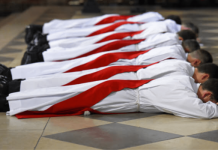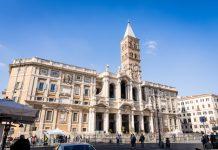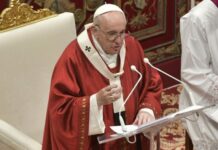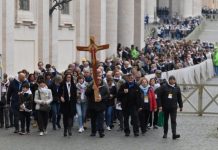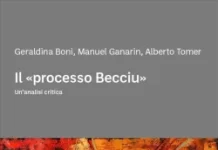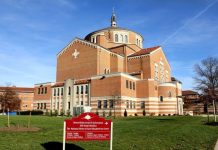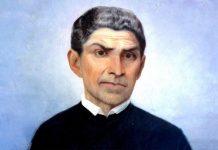The Protestant Revolt, by its very characteristics, origins and consequences, had no divine inspiration, because it was not based on the search for Truth.
Newsroom (21/02/2022 10:53, Gaudium Press) In this article, we will demonstrate the role of the Catholic Church as the exclusive and irreplaceable representative for the propagation of the gospel of Christ through a historical-philosophical argumentation, presenting findings that are still visible in our society and that are irrefutable by anyone of good conscience.
The Middle Ages and the Height of Christianity (10th to 13th Centuries)
Like any properly organised society, medieval society was composed of three groups: the people, the nobility and the clergy. The people provided agricultural and craft skills, which led to the emergence of trade. With the circulation of goods, the need for their protection arose, giving rise to the nobility, which held military power.
As a model of society inspired by the divine hierarchy and characterised by inequalities, it was known that the power of the sword should act for the good and be submissive to the power of God, represented by the Church and the Pope.
In short, medieval society had as pillars of its structure, firstly, the Pope, accepted as the supreme authority, because he was the Vicar of Christ on Earth and, secondly, the principle of unequal rights, since it was admitted that God did not make and does not want men equal, but similar.
Therefore, in order to destroy medieval society, it was necessary to overthrow these two pillars: the Pope and the inequality of rights. And these were, respectively, the targets of the revolutionaries of the Renaissance and, later, of the French Revolution.
The Renaissance and the Philosophical Errors of its Time (14th to 16th Centuries)
a) A Fight Against the Papacy
The Renaissance, romanticised by most writers as a period of flourishing arts and science, hides a harsh reality behind this veil of a beautiful rediscovery of Eastern culture. In philosophical terms, the Renaissance was a historical preparatory moment for the Protestant Reformation.
According to the Austrian historian Friedrich Heer, “the schism of the Holy Empire, which divided the Catholic Church into Eastern and Western, and the attempt to unravel the mysteries of the Eastern culture coming into Europe (due to the navigation and the crusades) tremendously influenced the philosophical and religious thought of the time. The patristic doctrine (of the Church Fathers), which until then had led to an adequate reading of the sacred scriptures, came to be considered only an allegorical form of interpretation…” (Intellectual History of Europe, pp. 82 and 83).
This abandonment of fidelity to the patristic interpretation gradually resulted in the circulation of new conceptions of the salvation of the soul, making room for the circulation of gnostic philosophies and rites of magic from the East.
This gnosis is the philosophical basis of all the sects opposed to the Church during the whole known historical period.
b) Heresies and Nationalism: the Set of Errors that Shaped Protestantism
The eagerness for the restoration of the unity of the Christian faith in Europe combined with the corruption of the values of part of the clergy and the circulation of Greek (pagan) writings among scholars resulted in a fertile ground for the emergence and propagation of new doctrines contrary to the magisterium of the Church, these new doctrines are called heresies.
Such errors were embraced by many princes and kings, who saw in such heresies an opportunity to advance their nationalistic ideas and to conquer lands and Church property.
This exacerbated nationalism in Germany had as its icon Martin Luther, who used an inadequate interpretation of the indulgences granted by the Church as a “spearhead” to start the Protestant Revolt, with the clear aim of usurping papal power over the German church and creating a new independent state.
Eric Voegelin, German Protestant philosopher, in his book Study of Political Ideas (ch. 7, pg. 109) neatly summarizes the misunderstanding regarding indulgences and their connection to the Reformation:
“The practice of indulgences was traditional and meant only the remission of the temporal punishments assigned in confession. The abuse begins with the popular misunderstanding in believing that indulgences meant the remission of guilt and not exclusively as remission of temporal punishment”.
The following are the main heresies that shaped the reformation, their characteristics and their legacy to Protestantism.
The Cathar Heresy
“The Cathars were the forerunners of the Italian humanists and the Protestant sectarians. With their dualism (god of evil and god of good), any understanding of the union between God and the world through the sacraments of the Church was totally impossible”.
They also “did not accept the existence of purgatory and believed in reincarnation” (Friedrich Heer. Intellectual History of Europe, pg. 116). For them, the god of evil would have created the material world, therefore, the whole material universe would be evil.
From the characteristics mentioned above, one can see that part of this philosophy was adopted by Protestantism in the following century and is also present in the spiritist movement of the 18th century.
Paul Sabatier, a Calvinist pastor of the 19th century, stressing the decisive role of the Pope in the confrontation with the Cathars, wrote in his work The Life of Saint Francis: “The papacy was not always on the side of reaction and obscurantism: when it defeated the Cathars, its victory was that of civilisation and reason”
The Waldensian Heresy
This heretical movement led by Peter Waldo “opposed honours paid to the Saints and prayers for the dead”. All kinds of external worship were considered idolatry. For them, the Catholic Church had been invented by Pope Sylvester in the time of Constantine and like the Cathars, they rejected the primacy of Peter” (Eric Voegelin. Study of Political Ideas, ch. 7, pg. 113). Their ideas and objections to the Catholic Church are also present in the Protestant designations of today.
The Nominalism of William of Ockham
In Germany, William of Ockham, who was Luther’s spiritual director, was an ardent defender of nominalism. This philosophy, which was also adopted by Luther, “taught a kind of anti-realism, denying the existence and therefore the reality of universals and abstract objects” (Friedrich Heer. Intellectual History of Europe, p. 131).
The result of this disconnect between reality and the divine overshadows the understanding of God’s grace and can be confirmed in the comments on Luther’s life presented below:
“Luther’s theology was forged in the crucible of his struggle to find forgiveness and peace for his overwhelming sense of guilt. He had an acute sense of misery and felt as if he stood in the balance between life and death (Trevor O’Reggio. A Re-examination of Luther’s View on the State of the Dead. Journal of the Adventist Theological Society, 22/2 (2011):154-170 – Seventh-day Adventist Theological Seminary – Andrews University).
“The human will is innately and inevitably evil and corrupted, and the desire for evil is invincible” ( H. J. Grimm. Disputation Against Scholastic Theology, in Luther’s Works 31).
Meistre Eckhart’s Irrationalist Gnosticism
Eckhart was a Dominican friar and preacher who taught theology at the University of Paris 200 years before the Reformation. His philosophy was considered heretical because it preached a Gnostic mysticism, claiming that our soul and God were one entity, and this unity was to be attained through spiritual exercises.
According to Peter Lillback, in his article Into the Mystic “Master Eckhart’s view of the immediate knowledge of God implied that the mystic actually became the divine nature,” an idea characteristic of gnosis. His mysticism and morality, which defended even the sanctity of sin, influenced Luther, a fact that can be evidenced by his following statements: “Be a sinner and sin strong, be strong in faith and believe in Christ…” (Letter No. 99 to Melanchthon, section 13, August 1, 1521). “There is the certainty of salvation by faith alone, even if we were to fornicate and murder a thousand times a day” (Joseph Denifle. Luther und seine Entwicklung, vol. 2, pgs. 1904-6). “The sin of sexual intercourse in marriage differs in no way from adultery and fornication” (Grisan V. Luther vol III, pg. 304). These ideas of Eckhart shed light on the emphasis of Luther’s Sola Fide doctrine, disregarding the important role of works in the pursuit of holiness and the justification of our sins.
Kabbalah and the Occult
In addition to its Gnostic connections, Protestantism also has deep connections with the occult and magic. Such elements were not openly used in the formulation of Reformed doctrine, but rather, used in a veiled way, even more fearfully, shaping the ideas and attacks on the magisterium of the church and on Thomistic philosophy.
As exponents of exoterism of the time, Reuchlin and Cornellius Agrippa made the connection between the world of magic and thought in Protestant circles.
“Reuchlin was one of the great propagators of the Jewish Gnosis, the Kabbalah, in intellectual and ecclesiastical circles in the fifteenth and sixteenth centuries, and was one of the great diffusers of Kabbalah in Reform and Renaissance circles” (Frances Yates. The Occult Philosophy in the Elizabethan Age, pg. 32, 1979).
Reuchlin’s close connection with magic, and its consequent connection with Protestantism can be confirmed in an article by Charles Zika, professor of history at the University of Melbourne, who says: “For him (Reuchlin), culture was not enough. He needed another philosophy in place of scholasticism, one which had power. He discovered this in Neoplatonism with its core of operative magic” (Reuchlin’s de verbo mirifico and the magic debate of the late fifteenth century Journal of the Warburg and Courtauld Institutes, 39:104-138, 1976).
Also in Germany, another prominent name in occultism that influenced Protestantism, and especially Luther, was Cornelius Agrippa, an exoteric writer who wrote the work De Occulta Philosophia, which deals with the advocacy of natural magic for obtaining angelic intervention on the material plane. “Magic is for Agrippa an alternative form of religious life” (Paola Zambelli. Magic and Radical Reformation in Agrippa of Nettesheim. Journal of the Warburg and Courtauld Institutes, Vol. 39 (1976), pg 71).
Frances Yates, in her book The Occult Philosophy in the Elizabethan Age (pg. 32, 1979), also mentions a cabalistic origin, characteristic of the Reformation: “Luther is the blunt reformer… with a reform program of a kind inherent in Christian Cabala, which aimed to replace scholastic philosophy with something more powerful.
Millenarianism
The millenarian heresy, “with roots also in the Hebrew religion” (cf. J. Servier, op. cit., chap. VI, “Desde el Talmud hasta la Reforma”), through an erroneous interpretation of the scriptures, was characterized by frequent attempts to predict historical events.
According to Eric Voegelin, in his book Study of Political Ideas (ch. 7, p. 28), millenarian beliefs are present in Marxist dialectics (primitive communism, class society and communism), in Hitler’s millenarianism, which aimed to build the perfect society in the Third Heich, and in later Protestant movements”, such as Adventism, characterized by the eagerness to foresee the second coming of the messiah.
The “Counter-Reformation”: The Attitude of the True Church in the Face of Decadence
The counter-reformation “was undertaken, not in response to the ‘reformers’, but in obedience to the demands and principles which form part of the Church’s unalterable tradition and proceed from her most fundamental loyalties” (Daniel Rops. The “Catholic Reformation.” Taken from the Fall 1993 issue of The Dawson Newsletter).
The regular orders made their first attempts at reformation in the 14th century (200 years before Luther). Attesting to God’s blessings on these men and women who restored true Catholic faith and morals, in the midst of Protestant unrest and conflict in Europe, countless miracles came to be conducted by God through the Saints.
We could also point out that all this restoration of the true faith and the purging of all those who tarnished the teaching of the Church, as was the case of Luther himself, was of paramount importance for his purification. And this conclusion is supported in Saint Paul’s letter to the Corinthians, where in chapter 11 he says: “I hear that there are schisms among you, and in part I believe it, because there must be dissensions among you, so that those of proven virtue may stand out”. Well, as the apostle said, those of proven virtue have stood out: the post-reformation Catholic Church.
Conclusion
It is thus concluded that the reformers, whose pride, greed and thirst for power instigated them to seek an interpretation of the sacred scriptures at odds with the Patristic interpretation, launched their curiosity into Gnosis and occultism, contaminating literature, monasteries and society with their Heresies and fomenting revolts which bathed Europe in innocent blood.
Such Gnostic and occult roots contaminated later the thought of many philosophers, such as Hegel, Kant and Nietzsche, who created the philosophical basis for the two other great revolutions that were to occur: the French Revolution and the Communist Revolution.
It is interesting to note that these revolutions always sought some kind of equality, breaking the hierarchy established by God, which was the model for society.
The Protestant Reformation attacked the Pope, demanding equal rights to interpret the sacred scriptures (free examination) and led to the Thirty Years’ War, where thousands of people died and more than 1,000 castles were destroyed.
The French Revolution demanded this same equality in the political sphere (down with monarchies) and guillotined 300 people a day in its first year of Liberty, Equality and Fraternity.
Finally, the Russian Revolution applied this same equality to the economic sphere, and to make this dream come true, it put to death around 200 million people.
Considering the above, and remembering the passage: “You will know them by their fruits. Are grapes gathered out of thorns and figs out of thistles” (Mt 7:16), is there still any doubt about the bad fruit and the absence of divine inspiration in the Protestant revolt?



